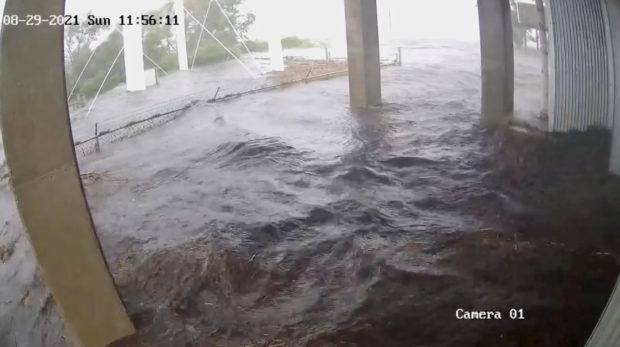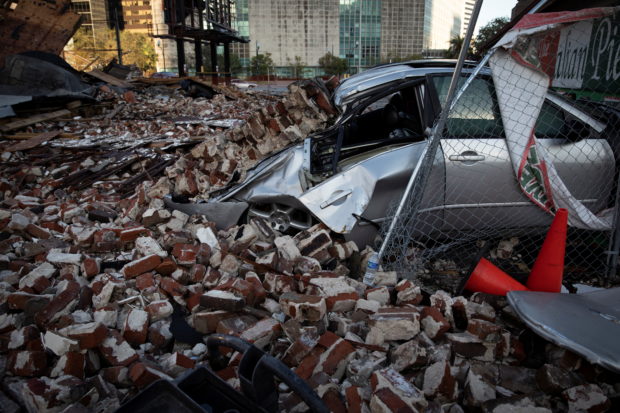In Ida’s wake, Louisiana residents could face a month without power

A security camera footage outside Fire Station #12 after hurricane Ida struck, in Delacroix, St. Bernard Parish, Louisiana, U.S. August 29, 2021 in this still image obtained from a video on August 31, 2021. (St. Bernard Parish Government / Delacroix Fire Station 12/Handout via REUTERS)
NEW ORLEANS – Residents in southern Louisiana braced for weeks without electrical power and disruption to their water systems in the wake of Hurricane Ida, one of the most powerful storms ever to hit the U.S. Gulf Coast.
By early Tuesday, about 1.3 million customers in the region were without power about 48 hours after the storm made landfall, most of them in Louisiana, according to PowerOutage https://poweroutage.us, which gathers data from U.S. utility companies.
The storm killed at least two people in the state, officials said, a death toll that may have been much larger if not for a fortified levee system around New Orleans, which had been devastated by Hurricane Katrina 16 years earlier. (Graphic of Hurricane Ida hitting Gulf Coast https://tmsnrt.rs/3yrcULP)
Entergy Corp, a major power supplier in the region, said it could take weeks before electricity is restored in the hardest-hit areas.
Damage to eight high-voltage lines shut off electricity in New Orleans and nearby parishes, and parts of a transmission tower toppled into the Mississippi River on Sunday night.
Article continues after this advertisementThe power outages have brought commerce to a standstill in New Orleans. The Hyatt Regency downtown was operating under a state of emergency and not accepting customers outside of emergency personnel, according to an automated message.
Article continues after this advertisementRestaurants, many of which had closed ahead of the storm, also faced an uncertain future due to a lack of electricity and other infrastructure, mirroring – at least for now – the issues that plagued businesses for weeks in the wake of Katrina.
“This is definitely feeling like Katrina,” said Lisa Blount, the public relations director at Antoine’s, a French Quarter landmark and the city’s oldest eatery. “To hear the power is potentially out for two to three weeks, that is devastating.”
Power officials have told leaders in Jefferson Parish that its roughly 440,000 residents may have to manage without electricity for a month or longer after utility poles toppled across the county, Councilman Deano Bonano told Reuters in a telephone interview.
“The damage from this is far worse than Katrina from a wind standpoint,” said Bonano. “We are going to be without with power for four to six weeks.”

A destroyed car is seen under the debris of a building after Hurricane Ida made landfall in Louisiana, U.S., August 31, 2021. (REUTERS)
Bonano said an elderly woman in the parish was found under her refrigerator on Monday and pronounced dead, and that he expected the death toll to rise, although not dramatically, once the water levels come down and full-fledged recovery efforts can get underway.
‘THEY HAVE NOTHING’
Some communities outside the levee system, including Lafitte and Grand Isle, were hit especially hard and the damage is still being assessed, the official said. More than half of the parish’s residents rode out the storm at home, Bonano said, and many were left with nothing.
“There are no grocery stores open, no gas stations open. So they have nothing,” he said.
Downed trees damaged underground water lines in the parish, and a majority of households were having to boil drinking water or cope with low pressure, according to Brett Lawson, chief of staff to a parish councilman.
Compounding the suffering, parts of Louisiana and Mississippi were under heat advisories, with temperatures forecast to reach up to 105 Fahrenheit (40.6 Celsius) on Tuesday, the National Weather Service said.
“The heat advisory for today does pose a big challenge,” the agency’s New Orleans outpost said on Twitter. “While you need to keep hydrated, know if you’re under a boil water advisory.”
Widespread flooding and power outages also slowed efforts on Tuesday by energy companies to assess damages at oil production facilities, ports and refineries.
HIGHWAY ‘WASHED OUT’
As the weather system traveled north on Tuesday and weakened, it unleashed heavy rain in neighboring Mississippi. At least wwo people were killed and 10 injured when a deep crevasse opened up on Highway 26 in George County, about 50 miles (80 km) northeast of Biloxi.
“We’ve had a lot of rain with Ida, torrential,” Mississippi Highway Patrol officer Calvin Robertson said. “Part of the highway just washed out.”
Seven vehicles plunged into the ditch, which was 50 feet (15 meters) long and 20 feet (6 meters) deep, Robertson said on CNN.
Officials warned residents about the hidden dangers of flood waters that might bring wildlife closer to neighborhoods.
Sheriff’s deputies in St. Tammany Parish were investigating the disappearance of a 71-year-old man after an apparent alligator attack in the flood waters brought on by the storm.
The man’s wife told authorities that she saw a large alligator attack her husband on Monday in the tiny community of Avery Estates, about 35 miles (55 km) northeast of New Orleans on Monday. She stopped the attack and pulled her husband out of the flood water.
Seeing that his injuries were severe, she took a small boat to get help, and came back to find her husband gone, the sheriff’s office said in a statement.
MEMORIES OF KATRINA
Ida made landfall on Sunday as a Category 4 hurricane, 16 years to the day after Hurricane Katrina, evoking memories of a disaster that killed more than 1,800 people in 2005 and devastated New Orleans.
But a $14.5 billion system of levees, flood gates and pumps designed in the wake of Katrina’s devastation largely worked as designed during Ida, officials said, sparing New Orleans from the catastrophic flooding that devastated the area 16 years ago.
The state’s healthcare systems also appeared to have largely escaped catastrophic damage at a time when Louisiana is reeling from a resurgence of COVID-19 infections that has strained hospitals.